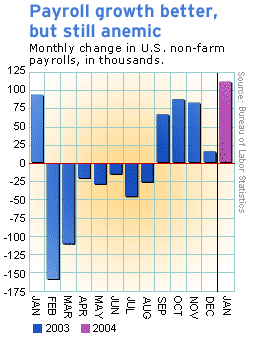NEW YORK (CNN/Money) -
A closely watched measure of consumer confidence in the United States tumbled in February, according to a published report Friday, coming in well below Wall Street forecasts.
The University of Michigan's preliminary consumer sentiment index for February sank to 93.1 from a revised 103.8 in January, according to market sources quoted by Reuters. Economists, on average, expected a reading of 103.3, according to Briefing.com.

"People are seeing we're not getting job growth, even though there have been a lot of promises of it," said Delos Smith, senior economist at the Conference Board, a private research firm that publishes its own monthly consumer confidence survey. "That's the key; for people to be satisfied, you have to have job growth."
The university's preliminary index is based on telephone interviews with 250 households. An updated number will be released later in the month with the results of 500 interviews. The Conference Board, in comparison, surveys about 5,000 households. And while its confidence index has risen in recent months, its measures of job-market confidence have shown lingering weakness.
The University of Michigan's current conditions index, a measure of how consumers feel about the present state of the economy, dropped to 100.4 in February from a revised 109.5 in January, according to the numbers quoted by Reuters.
The expectations index, measuring consumers' hopes for the near future, fell to 88.4 from 100.1 in January.
On Wall Street, stocks seesawed, then fell after the report, while Treasury bond prices rose.
Jobs key to consumer spending
Investors and economists pay a close eye on consumers, whose spending makes up more than two-thirds of the nation's economy. Of course, many on Wall Street realize that consumers don't always spend the way they feel.
Confidence plunged after the terror attacks of Sept. 11, 2001, for example, but consumers still managed to make their way to auto dealers to buy cars at zero-percent financing.
| Related stories
|

|
|
|
|
Similarly, consumers have continued to spend, even though the labor market has been in its longest stretch of pain since the Great Depression. While the unemployment rate is lower than in other market downturns, displaced workers have had a difficult time finding work, and payrolls have been the slowest to recover since the Labor Department started keeping track in 1939.
Nevertheless, fueled by tax rebate checks and cash from a wave of mortgage refinancing, consumers hit the malls with gusto in the third quarter, pushing economic growth to the fastest annual pace in nearly 20 years. Those stimulative effects faded in the fourth quarter, and the pace of consumer spending growth slowed down.
Many economists hope that increased hiring in 2004, along with tax-refund checks in the first half of the year, will help consumers' incomes grow, supporting continued spending.
But other analysts worry that businesses are still too cost-conscious to start hiring in great numbers. They suspect that productivity -- a measure of output per worker hour -- will continue to grow at its recent robust pace, helping corporate profits and setting the stage for higher employment and living standards in the future, but keeping hiring sluggish in the meantime.
Anthony Chan, chief economist at Banc One Investment Advisors, said history shows productivity tends to decline in the third year of economic expansions -- which 2004 will likely be.
Chan expects productivity to decline to about a 2.7-percent rate of growth this year and for the economy to grow at about a 4-percent pace, lower than most economists' forecasts. That combination would result in job growth of about 1.3 percent, or about 1.7 million new jobs -- not blockbuster job growth, by any stretch, but a lot better than it has been, at roughly 150,000 new jobs a month.
Chan also warned, however, that if his forecast was wrong, it was more likely to be wrong in the direction of higher productivity and less job growth, given the fact that companies continue to face global pressure to keep prices and costs low.
"More globalization means there's more pressure to increase productivity, not to reduce it. No pricing power means there's more pressure to increase productivity, not less," Chan said. "There's so much pressure to push it higher, it will be difficult for cyclical factors to push it lower."

|

